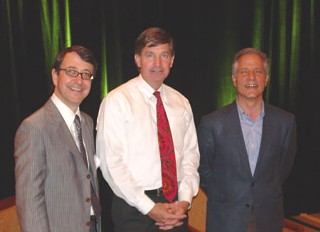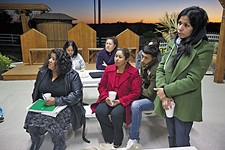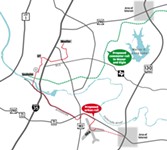Developing Stories
Community Convergences
By Katherine Gregor, Fri., Nov. 9, 2007

Photo courtesy of Garland B. Hilton III. All rights reserved.
On the city-making circuit this fall, something feels different. At events organized to address how Austin can best develop and grow – whether convened by the business sector, community nonprofits, or the city of Austin – what's notable are the converging lines of conversation. Across old bipartisan and enemy-camp lines, advocates are coming together to craft workable solutions to specific community problems. Instead of draining their energies sparring, divergent groups are collaborating productively to get good things done. It's far from a perfect world, of course – plenty of adversarial battles rage – yet the noticeable migration to common ground is heartening.
Approaching Zero
Take the Zero Energy Capable Homes Task Force. Its mission: requiring homes so energy-efficient (consuming about 65% less energy than the average new home today) that, with the addition of solar panels, they could in principle consume zero energy. An initiative allied with the city's Austin Climate Protection Plan, the public-private stakeholder task force achieved a once-impossible feat. The traditionally conservative Home Builders Association of Greater Austin has endorsed stricter regulation of its own industry – a new city building-code ordinance designed to address global warming. On Oct. 18, City Council approved a resolution adopting the task force's report and directing the city manager to do what it takes to make all new single-family homes constructed in Austin "zero energy capable" by 2015. The city will tighten the building code in phases, starting now by increasing energy efficiency by 11%. "The biggest winners are homeowners," said a smiling Mayor Will Wynn, citing lower utility bills and clean air benefits, as he called zero-energy homes "a strategic win for homeowners, business, and the environment."
Austin Energy green-honcho Roger Duncan said that when he tells this Austin story at national events, "people are just stunned." They ask, "How on earth did you convince the home builders to do this? That's the most stunning news we have to deliver around the nation." Other cities and states are attentively watching; one of Wynn's goals is to kick-start a copycat movement. Austin Energy's many years of promoting green building helped it to happen here first.
Observed custom home builder Ray Tonjes, "This is one of the first times in Austin that they've truly engaged the stakeholders in the building industry." He credited Richard Morgan in the city's Green Building Program for getting the right folks around the table, with a willingness to work together to develop consensus-based building-code revisions. "There's a new spirit of cooperation between our industry and the policy-makers," observed Tonjes, who also chairs the Green Building Subcommittee of the National Association of Home Builders. He noted that $90-per-barrel oil and consumer market demand for "green" homes didn't hurt in bringing the usually conservative industry around to the virtues of energy efficiency. You say oil independence; I say climate protection: Let's pull the whole thing off.
Making Bedfellows
At the Oct. 19 event Boom to Best: The Future of Central Texas, participants heard from Andrés Duany and Hank Dittmar that – as swell as green building is – intelligent land-use planning is even more critical to crafting a comprehensive solution to global warming. "One-third to two-thirds of C02 loading is caused by urban patterns, not buildings," Duany said. "Urbanism is at the heart of the solution and at the heart of the problem." He and Dittmar spoke at the Envision Central Texas event to stir up advance community interest for the Congress for the New Urbanism national conference, to be held in Austin next April 2-6. Urban planner Duany is a CNU co-founder; CNU board Chair Dittmar is a UT grad who serves as chief executive of the Prince's Foundation for the Built Environment. "How we shape our cities is a key part of mitigating and adapting to global warming," asserted Dittmar. Asked later for examples of cities doing a good job integrating urban land-use planning with climate protection, Duany said, "Vancouver, Vancouver, and Vancouver." Indeed, that city's EcoDensity initiative (www.vancouver-ecodensity.ca) offers a stellar example for Austin.
Who were Envision Central Texas' event co-sponsors? None other than the Real Estate Council of Austin and the Austin Chamber of Commerce – longtime right-leaning economic development boosters. Now, "RECA believes that achieving a sustainable balance of economic, social and environmental interests is critical to the long-term vitality of our community." Mayor Will Wynn moderated; introducing the progressive speakers was Republican state Rep. Mike Krusee.
Dittmar pointedly extolled the virtues of urban rail transit, noting, "A circulator is really implicated for Austin – a low-cost streetcar." Gee, what a synchronistic setup for the mayor's Oct. 25 call-to-action at the Downtown Austin Alliance annual luncheon: calling for a voter referendum on circulator/streetcar rail in November 2008. (See "Wynn Calls for 2008 Rail Vote," Oct. 26.) Then, the chamber's Take on Traffic initiative announced on Nov. 1 a new yearlong partnership with the Environmental Defense Action Fund – yet another fascinating coupling. Will ED, which is calling passionately for congressional action on global warming, help the chamber get out the vote for streetcar transit?
The Eastside Perspective
Yet another cross-sector convergence occurred at the Oct. 13 East Austin Economic Summit. Organized by PeopleFund, the fifth annual event was underwritten by WaMu (the bank formerly known as Washington Mutual, now unfortunately rebranded as Chinese food) and supported by a diverse and well-rounded roster of corporate, governmental, nonprofit, and private stakeholders. At a session on East Austin development, new projects covered included affordable, market-rate, and mixed-use housing such as La Vista de Guadalupe, Chestnut Commons, Mueller, and an interesting rental co-housing community being pursued by Esperanza Development.
The problematic context, of course, is gentrification and diminishing housing affordability in East Austin. While investment in a disinvested community is in theory a good thing, on the Eastside it's happening so fast that longtime residents are being displaced. As one speaker put it: "The tidal wave of market forces is rising too quickly, with little or no time to adjust. The dam has broken, and the water is coming over." In the 78702 ZIP code, for example (bounded by I-35 and Airport Boulevard, between the river and Martin Luther King Boulevard), the median sale price of a home in 2000 was $77,000. It since has shot up more than 250% to $195,000 (with a 150% increase just since 2005), with property taxes to match. State Rep. Eddie Rodriguez talked about how the city's Homestead Preservation District (under his House Bill 470) can help East Austin housing values "slow down, so people don't have to move to Pflugerville" – which has been absorbing Austin's displaced African-American community. Rodriguez noted, "Moving to outlying areas contributes to our traffic problems" – which in turn contribute to air pollution and CO2 emissions. Back to EcoDensity.
Capital Metro spokesman John-Michael Cortez spoke about the 25% goal for affordable housing within the city's transit-oriented development zones. He cited statistics from Reconnecting America, showing the average U.S. family spends 32% of its budget on housing and 19% on transportation. In a transit-oriented development, transportation costs drop dramatically to 9%; in exurbia, they rise to 25%. For every dollar saved on housing by moving out from the central city, an average household spends 77 cents more on transportation. Effective affordability initiatives, then, must address bundled housing and transportation costs.
Getting to Everybody
That point was germane at the meaty Affordable Housing Summit hosted by Council Member Jennifer Kim on Oct. 25. The event – to begin a substantive market study of real conditions and needs – drew another impressive cross-section from the community, including developers, bankers, home builders, representatives from numerous Eastside neighborhood groups, nonprofits, and city departments. The ultimate goal: an Austin 2035 Plan for affordable housing. Real Estate Council of Austin Vice President Tom Terkel gave a thoughtful talk on the real estate industry's self-interest in ensuring sufficient affordable housing; he expressed open frustration with how long it has taken the city to act on the recommendations of the Affordable Housing Incentives Task Force. (Kim said city staff is ready to use the task force formulas on an interim, pilot-project basis.) And he asserted, "Unless people of all incomes can live here with decency and dignity, we won't have a city that's very attractive to anyone for very long." Then, appealing to the diverse interests in the room, Terkel made a plea: "Don't reject the ideas of those who have different points of view from you out of hand."
Could Austin be reaching its tipping point as a maturing, effectively progressive city? Should we credit Envision Central Texas for boosting awareness that diverse interests must work together to achieve regional goals? Has the looming necessity of cross-boundary action on global warming nudged people's thinking toward a broader solidarity? Whatever, the bracing civic goodwill in the air nicely complements the crisp autumn weather.
DEVELOPING HAPPENINGS: Upcoming Events and Meetings
• UT System Regents will hear public comments on the redevelopment of the Brackenridge Tract at 1:30pm Friday at Ashbel Smith Hall, 201 W. Seventh. Submit an advance request to speak, or send written comments to [email protected].
• The American Independent Business Alliance will hold its first national conference in Austin Nov. 9-11. It will showcase the work of the Austin Independent Business Alliance as a positive model of how to support and promote locally owned businesses.
• The Alley Flat Initiative is an Austin housing solution that's both affordable and green/sustainable (www.thealleyflatinitiative.org). To learn more, stop by an informational happy hour at Nuevo Leon, 1501 E. Sixth, on Monday, Nov. 12, from 5:30 to 7:30pm. The small-scale density initiative will produce additional housing on existing lots. The prototype project in progress is two small alley flats (secondary dwelling units) for Eastside families. Featured in the PBS/BBC TV series design: e2, the project is also a model of local collaboration – partners include the UT Center for Sustainable Development and the Guadalupe Neighborhood Development Corporation, among others.
• HousingWorks Action's fourth annual community housing summit is this Saturday, Nov. 10, from 8am to 12:30pm at Fulmore Middle School. Breakfast provided. The summit focus: correlations between affordable housing and school performance. How do families select where to live and quality schools, and how do those choices in turn affect population patterns, transportation issues, and the environment?
• The city is progressing steadily with its work on improved rules for planned unit development zoning. The effort promotes better projects on large tracts that exemplify intelligent urban design and provide substantial community benefits. The next public stakeholder meeting is Friday, Nov. 9, from 9 to 11am at City Hall. For more info, contact Andy Moore, aide to Council Member Mike Martinez, 974-3036.
• Learn how Dallas has shot ahead of Austin by adopting an up-to-date comprehensive plan in June 2006. Theresa O'Donnell, director of development services for the city of Dallas, will speak on the Forward Dallas! plan on Friday, Nov. 9, as part of the architecture school's CityForum series, noon-1:30pm, UT campus, 3.120 Goldsmith Hall (just south of the Union on Guadalupe). Dallas' first comprehensive land-use plan includes a statement of vision, a policy plan, and an implementation plan. (Dallas now is developing district plans.) It encourages greater use of mixed-use development, increased density that supports the city's expanding light rail system, and greater housing diversity – all hot issues for Austin, as well.
• Learn about the draft station-area plans for the city's transit-oriented development districts at next week's public open-house presentations. The consultant team will present the main elements of the station-area plans: land use, circulation, and open space; TOD zoning; affordable housing; and implementation and finance. The public is invited to comment and provide feedback. Final plans will be presented to the Planning Commission and City Council early next year. Information will be posted on the transit-oriented development station-area planning Web page after the meetings: www.ci.austin.tx.us/planning/tod/default.htm. Open House Presentations:• Lamar/Justin transit-oriented development: Tuesday, Nov. 13, 5:30-9:30pm, First Unitarian Universalist Church, 4700 Grover• Plaza Saltillo TOD: Wednesday, Nov. 14, 5:30-9:30pm, Metz Elementary, 84 Robert Martinez Jr. St.• MLK Boulevard TOD: Thursday, Nov. 15, 5:30-9:30pm, Parque Zaragoza Recreation Center, 2608 Gonzales
• Buried in the 500-page proposed Balcones Canyonlands Preserve land management plan is language that would ban all dogs, on or off a leash. But by city ordinance, Turkey Creek is an off-leash trail, according to advocate Glenn Gadbois. A final decision on the plan will be made in mid-November by the Balcones Canyonlands Coordinating Committee; Mayor Will Wynn and Travis Co. Commissioner Gerald Daugherty are voting members. A public hearing will be held at City Council on Nov. 8, at 6pm.
Got something to say on the subject? Send a letter to the editor.










